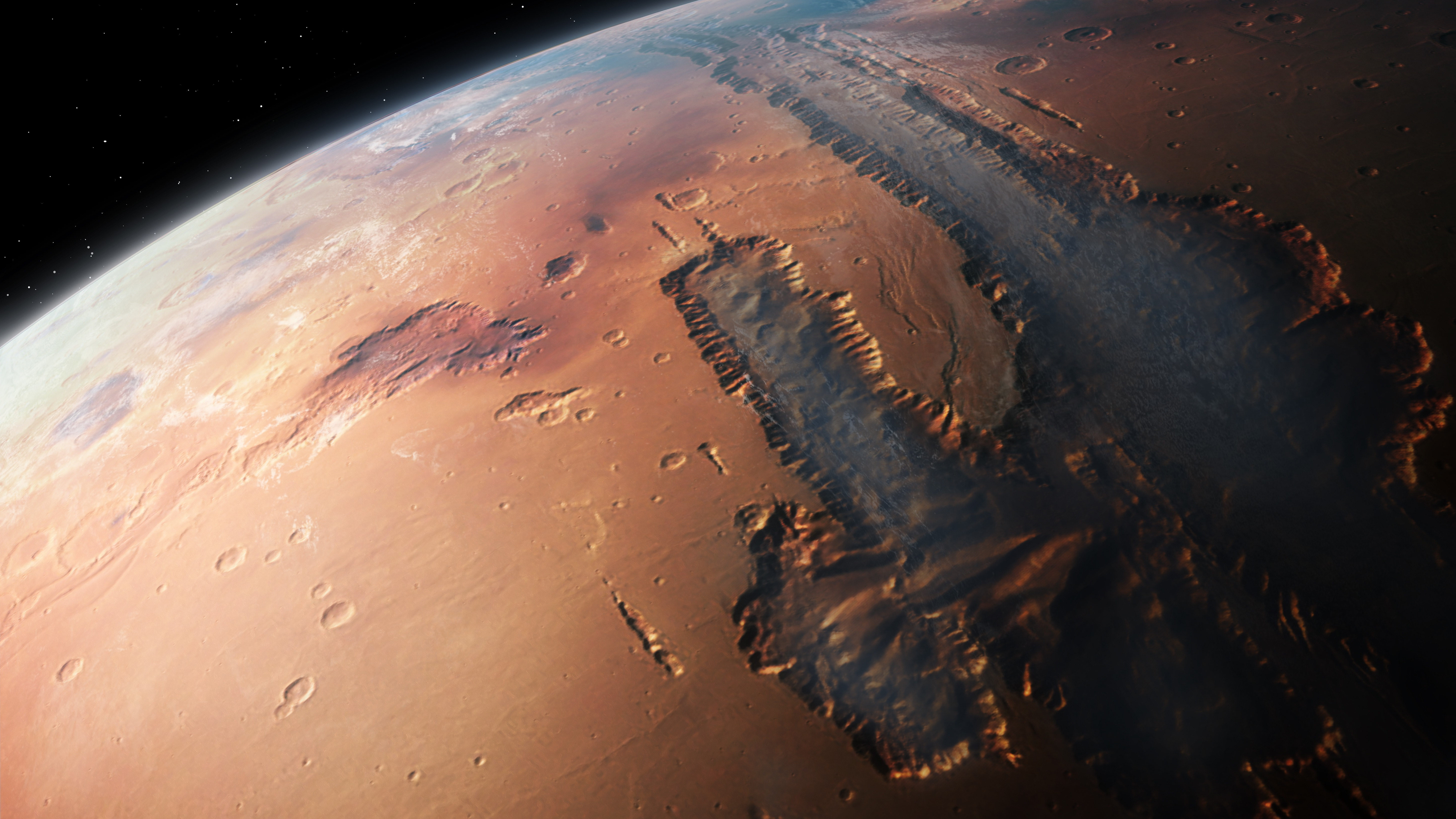This literary sci-fi odyssey should be Netflix’s next big-budget adaptation
The Mars Trilogy would make for the perfect Netflix series

There’s a rich vein of literary sci-fi adaptations on the best streaming services right now. The likes of 3 Body Problem on Netflix, The Expanse on Prime Video and Foundation on Apple TV+ all started life as popular books. But there’s one particular trilogy that hasn’t yet been touched by the small screen and I just can’t work out why.
The Mars Trilogy, by noted sci-fi author Kim Stanley Robinson, was released way back in the mid-1990s. The books have won both Hugo and Nebula awards and cover the journey of the first humans to Mars and the subsequent colonization and terraforming of the Red Planet. If you’ve not come across the series yet (and consider yourself a fan of sci-fi), you’ll want to pick them up right now ($52 in paperback from Amazon) and get reading. Fair warning though: it’ll take time. The novels are gargantuan and filled with scrupulous scientific detail on how a bunch of astronauts train for, journey to and then settle into an alien world. I’m about part-way through the last book in the series, Blue Mars, right now and I can’t fathom why this hasn’t been turned into a show yet.
I’m about part-way through the last book in the series, Blue Mars, right now and I can’t fathom why this hasn’t been turned into a show yet.
I’m clearly not the first to wonder this. It seems the mighty James Cameron initially held the screen production rights in the late ‘90s with plans to turn Robinson’s work into a five-hour miniseries. Since then, the rights have apparently passed to Spike TV which is looking to develop a show from Red Mars, the first book in the series. But, according to a report from Deadline in 2016, the project has stalled after showrunner Peter Noah exited the project and now it’s presumably stuck in development hell.
Why turn The Mars Trilogy into a series?

I have a pretty fundamental reason for wanting this book series turned into a TV show: although there’s so much material to draw on, there’s also a lot that can be trimmed out. Books and TV shows are fundamentally different mediums and I don’t think showrunners should slavishly follow the pages of a bestseller just as authors shouldn’t add pages of description in the hopes of wooing Hollywood execs. Some of the best screen adaptations are those that aren’t afraid to make changes to the denser parts of the source material — Peter Jackson’s cinematic adventures in Middle-Earth spring to mind.
The Mars Trilogy contains around 2,000 pages and delves into a vast number of subjects: theoretical physics, economics, sociology, politics and psychology to name just a few. These topics are wrapped around the lives of an ensemble cast of characters starting with the “First Hundred” who settle on Mars before expanding to include their offspring as well as secondary and tertiary characters from both Mars and Earth. Of these, only fifteen or twenty are really focused on throughout the books but Robinson gives each one a distinct personality with plenty of depth.
All of which means there’s loads and loads for a potential show to draw on. Anyone making it could lean into the romances and interpersonal relationships of the characters and dial back on the science. Or, alternatively, lean into the theory and the science and cut out a lot of the extraneous politics. But either way, it’ll make a good series precisely because there’s opportunity for a scriptwriter and editor to pick and choose from what’s there in Robinson’s text to make it a streamlined and enthralling sci-fi epic. Those of us that want to meticulously work our way through descriptions of Martian geology have the books to fall back on.
It should be made in 2024 (or 2025)

I’m confident that, despite the age of the source material, the next few years would be the perfect time to adapt the trilogy to the screen. Some of the predictions Robinson made 30 years ago are eerily prescient. For example, AI plays a huge part in proceedings and assists the humans in everything from data retrieval to real-time translation. Communication with AI or other people is done via wrist-based video pads, not unlike the best smartwatches of today. Other areas of tech discussed in the book, such as the longevity treatment that allow people to live well past 100 years old, are also extremely topical right now.
But even more importantly, Mars itself is having a moment.
Kim Stanley Robinson says he got the idea for setting a novel there when he was looking at maps of the planet and figured it’d be a good place to go hiking. In the intervening years, the fourth planet from the sun is looking an increasingly likely destination for human habitation. The first book in the series, Red Mars, actually starts in the year 2026 with the first hundred voyaging to Mars aboard the Ares, the largest spaceship ever built as part of a joint American-Russian mission. And while Robinson got the date slightly early, it doesn’t seem like he’ll miss by much.
NASA is working to put humans on the Red Planet in the 2030s and (when he’s not busy wrecking Twitter or trying to salvage the Cybertruck) Elon Musk’s much-touted prime directive is to make humans a multiplanetary species with SpaceX building rockets that’ll fly us to Mars.
It’ll look stunning

You may not be interested in the fact astrobiologists have found organic materials in sediment at the bottom of a three-and-a-half-billion-year-old lake on Mars. But you can’t deny the distant world is a visually appealing setting for a sci-fi series.
The highest elevations on Mars are found on the Tharsis Bulge, a huge volcanic plateau that’s home to the largest volcano in the solar system. Olympus Mons is twice the height of Everest and to the west are the lowlands of Amazonis Planitia, where ferocious dust storms can last for weeks. Meanwhile, to the south east lies the Valles Marineras (named after the Mariner 9 spacecraft) canyon that utterly dwarfs anything on Earth. Just for context, the Grand Canyon would fit into one of its side channels with room to spare.
Meanwhile, the Hellas impact basin is the largest clearly visible impact crater in the solar system and is over nine kilometers deep. The atmospheric pressure at the base is twice that at the rim. Despite being smaller than Earth, the altitude differences on Mars are huge — it’s an asymmetrical planet with the northern hemisphere being around 5.5km lower in altitude than the southern. All these land features were mapped in the 1990s by Nasa’s Mars Global Surveyor spacecraft and play an integral role in the books. Imagine how awesome they’d look when the special effects department rolls up their sleeves and gets to work.
As a sci-fi fan, I’ve loved recent efforts from the best streaming services — but a fully realised Mars Trilogy would be the icing on the intergalactic cake. And to prove I'm not the only one who thinks this TV show needs to be made, here's a fun trailer for Red Mars my colleague Ryan Morrison created using AI. Take note, Netflix.
More from Tom's Guide
Sign up to get the BEST of Tom's Guide direct to your inbox.
Get instant access to breaking news, the hottest reviews, great deals and helpful tips.

Jeff is UK Editor-in-Chief for Tom’s Guide looking after the day-to-day output of the site’s British contingent.
A tech journalist for over a decade, he’s travelled the world testing any gadget he can get his hands on. Jeff has a keen interest in fitness and wearables as well as the latest tablets and laptops.
A lapsed gamer, he fondly remembers the days when technical problems were solved by taking out the cartridge and blowing out the dust.
